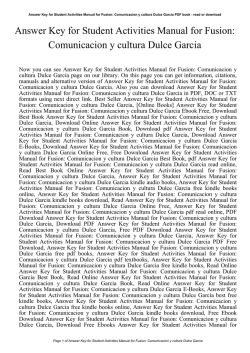
Pseudochattonella cf. verruculosa
Climatic anomalies and harmful flagellates blooms in Southern Chile Prepare by : Alejandro Clément L. Lincoqueo, M. Saldivia, C. G. Brito, F. Muñoz, C. Fernandez, F. Perez, C.P. Maluje, N. Correa Serra Martins Silva, V. Moncada, G. Contreras & R. Crescini [email protected] Plancton Andino SpA. Phone : + 56 - 65 - 223 5046 Puerto Varas, Castro & Coyhaique, Chile. Florianopolis October 13, 2016 www.plancton.cl 1 NOAA: Warmest year on Record 2015 https://www.climate.gov/news-features/featured-images/no-surprise-2015-sets-newglobal-temperature-record 2 Calbuco volcano eruption 2015 Rivers flux Glacial field Source: NASA/GSFC www.plancton.cl 3 (Silva & Neshyba, 1977) WEST WIND DRIFT CURRENT (Sievers & Silva, 2006) South Pacific Anticyclone or Anti-ciclon del Pacifico Sur (APS) Surface isothermal temperature distribution and the 4 divergence of the WWDC at Chiloé Island latitude. Objective To analyze the photo-autotrophic flagellates summer-fall blooms in Southern Chile with more emphasis in P. cf. verruculosa www.plancton.cl 5 Basic Conceptual Model of key Water Column interactions with aquacultures activities in fjords systems (Clément 2013) www.plancton.cl 6 INTRODUCTION 1. Exceptional summer-fall climatic anomalies and/or “El Niño” signals during 2016. 2. Several HABs in fjords & oceanic coastal waters with enormous social & economic impacts. 3. These blooms have been the most damaging in South America with losses > than US$ 600 M. 4. Main species were Pseudochattonella cf. verruculosa, and Alexandrium catenella, among others flagellates. 5. Blooms were independently on a spatial and temporal scale www.plancton.cl 7 Milestones during 2016 HABs 1. 2. 3. During 2009 we detect A. catenella cells in the coastal ocean Pseudochattonella cf. verruculosa first time 2004 and 2009. Jan. 21, 2016 we observed first salmon kill Chiloe Archipelago due to Pseudochattonella cf. verruculosa. Nice weather, high temperature and solar radiation. http://agromet.inia.cl/estaciones.php?watch=2022 1. During mid summer we observe usual temporal-spatial pattern of A. catenella in southern Chiloe and Chonos Archipelago. 1. 2. 3. 4. Same pattern as previous events. 2002 and 2009 Late February & first week of March occurred massive salmon kills (40000 ton) due to a bloom ( aprox 5000 cel/mL) of Pseudochattonella cf. verruculosa (Clément et al 2016). End of March PSP outbreak coastal ocean (Data Minister of Health available at http://seremi10.redsalud.gob.cl/?p=6034 April 14 A. catenella Chacao channel & max cell abundance April 28. www.plancton.cl 8 METHODOLOGY • Climatological data www.meteochile.cl NOAA • Data base analysis http://sispal.plancton.cl/clientes/ • During the bloom Biological, Optical & Physical variables. – Fast Repetition Rate Fluorometry (FRRf3). Chelsea Tech Group • Active chlor a fluorescence (Fo, Fm, Fv, Absorption Cross Section, among other photochemical parameters at PSII). – Seabird Electronic CTD-O profile, – Ecotriplet Fluorometer, WetLabs Inc. in situ chlor a, Backscattering Bb(460 & 660 nm) • Phytoplankton composition and abundance. • More than 35 d during Summer-Fall of 2016. www.plancton.cl 9 MAIN RESULTS 1. Patches P. cf. verruculosa, with record (>5000 cells/mL). 2. High chlor a > 38,4 mg/m3 & high photosynthetic efficiency rates [(Fv/Fm)]= Ef. Fv = Fm – Fo 3. Sub-surface max, above the pycnocline based on cells counts, in situ Chlor a, Bb (λ), Fo (> 10) ; Fm (> 20) & Ef 1. Essential features of P. cf. verruculosa bloom were 1. remarkable thin layer formation and 2. an extremely Ichthyo-toxic cells. www.plancton.cl 10 Inter-annual ONI El Niño Index region 3.4. ONI NOAA, Climate Prediction Center. http://www.cpc.ncep.noaa.gov/products/analysis_monitoring/ensostuff/ensoyears.shtml 2015 0.6 0.5 0.6 0.7 0.8 1.0 1.2 1.4 2016 2.2 2.0 1.6 1.1 0.6 0.1 -0.3 -0.5 1.7 2.0 2.2 2.3 Positive Air Temperature Anomaly, last 10 years warmer than the past Fuente: Dir. Meteorología de Chile. 12 Precipitation Anomaly; after 2008 important change 10 years in a row with less rain fall 13 Salmon farms mortality due to Pseudochattonella blooms January and first half of March 2016. www.plancton.cl 14 Phytoplankton Abundance, Pseudochattonella, In situ Chlor a Fluorescent, Temp, & Sigma-t. 7-3-16, 14:51 www.plancton.cl 15 Thin layer formation and decay www.plancton.cl 16 www.plancton.cl 17 Water Column Profiles Reloncabvi Soun march 2016. 2.3.15 0 0,000 0 5 5 10 10 12 16 18 Profundidad (m) 10 Profundidad (m) Particulate Backscattering Temp (°C) 14 15 20 25 30 0,010 0,020 0,030 15 Bbp470 20 Bbp660 25 35 30 40 35 DO (mg/L) 0 2 4 6 8 10 12 0 Profundidad (m) 5 10 15 20 25 30 35 40 www.plancton.cl 18 www.plancton.cl 19 www.plancton.cl 20 * > [chlor a] thin layers above pycnocline 10 m. • Max [chlor a] near the 7 to 10 m Deep. www.plancton.cl • . 21 Fast Repetition Rate Fluorometry ( 3) Induction Curve. Pseudochattonella A. catenella Skeletonema . Financiamiento Proyecto FONDEF www.plancton.cl 22 Photochemical profile HAB features www.plancton.cl 23 Thin layer dynamics of Pseudochatonella during peak & decay of BLOOM * > concentración clor a en capa finas cerca de los 10 m de profundidad. • Valores de clor a máximos se han encontrado cercanos a los 10 m de profundidad. • Estas capas han aumentado Clor a el Domingo 6 y Lunes 7, comparado con semana pasada. 24 Final Remark 1. Thin layer chlor a max was coherent with the highest temporal peak of the active photosynthetically cells during the P. cf. verruculosa bloom. The climatic anomalies & vertical dynamics of thin layer are key issues in the formation and decay of P. cf. verruculosa bloom. Changes in water column structure implies HAB decay. 2. Synergistic effects in gill damage and impact L. danicus & Pseudochattonella 3. Climatic anomaly largely explains the HABs observed in southern Chile in summer and autumn 2016. 4. West Wind Drift (WWDC) shift south due to position of High Pressure in the South East Pacific Ocean implies northward transport of cells from coastal Chiloe. 1. agrad www.plancton.cl 25
© Copyright 2026

